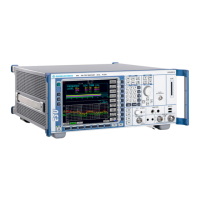R&S ESU Instrument Functions
IF Spectrum Analysis Mode
4.78 Operating Manual 1302.6163.12 - 03
The measurement time of the bar graph may be longer than the measurement time
of the IF analysis. If the measurement time of the bar graph is set to a smaller value
then the measurement time of the IF analysis, the bar graph will as often be
refreshed as the display of the IF analysis.
Table 4-4 Measurement time (data-recording time) for the possible span-RBW-
combinations
The level display of the IF analysis is unweighted. It is independent of the selected
detector for the bar graph measurement, e.g. average or quasi peak. This is indi-
cated by the label SA (for sample detector) on the left side of the IF analysis display.
A maximum of three traces can be displayed in parallel. The display mode –
CLEAR/WRITE, MAX HOLD, MIN HOLD, AVERAGE, VIEW or BLANK – may be
selected independent for each trace.
The IF display does switch on the 6 dB EMI resolution bandwidth filters for the bar
graph measurement. 3 dB or channel filters are not possible in the IF analysis mode.
The maximum span for the IF analysis is limited to ten times the selected resolution
bandwidth for the bar graph measurement. This is due to the dynamic range of the
bar graph measurement.
The IF analysis mode is selected using the IF hotkey (see also section “Mode Selec-
tion – Hotkey Bar” on page 4.9)
RBW
Span 10 Hz 30 Hz 100 Hz 300 Hz 1 kHz 3 kHz 10 kHz 30 kHz 100
kHz
1 kHz 384 ms 128 ms
2 kHz 384 ms 128 ms
5 kHz 384 ms 128 ms
10 kHz 384 ms 128 ms 38,4 ms
20 kHz 384 ms 128 ms 38,4 ms
50 kHz 128 ms 38,4 ms 12,8 ms
100 kHz 38,4 ms 12,8 ms 3,84 ms
200 kHz 38,4 ms 12,8 ms 3,84 ms
500 kHz 12,8 ms 3,84 ms 1,28 ms
1 MHz 3,84 ms 1,28 ms 384 µs
2 MHz 3,84 ms 1,28 ms 384 µs
5 MHz 384 µs 128µs 38,4 µs
10 MHz 384 µs 128µs 38,4 µs
The displayed level values do have the full accuracy of the instrument only at the
center frequency. At all other frequencies, the level is typically lower due to the fre-
quency response of the IF filter and the preselector.

